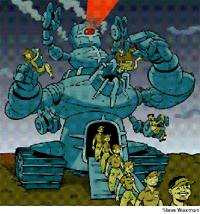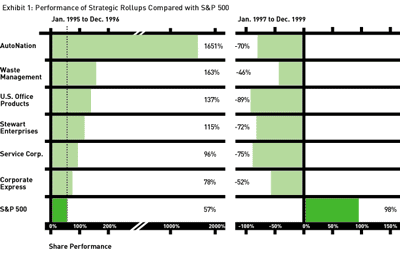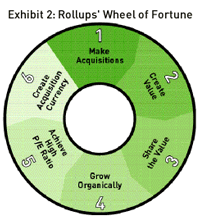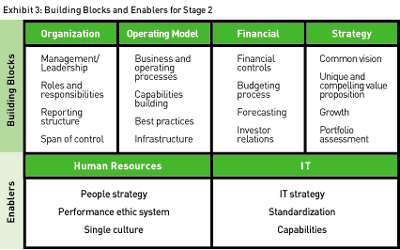Strategic Rollups: Overhauling the Multi-Merger Machine
The acquisitions binge of the '90s has turned into the value trough of today. Here's how to rebuild a vacuumed company.
 Take a highly fragmented industry, like used-car sales, funeral homes, office supplies, air-conditioning services, veterinary care, or laboratory diagnostics. Buy up dozens, maybe hundreds, of owner-operated businesses. Create an entity that can reap economies of scale, build regional or national brands, leverage best practices across all aspects of marketing and operations, and hire more potent managers than the small businesses could previously afford.
Take a highly fragmented industry, like used-car sales, funeral homes, office supplies, air-conditioning services, veterinary care, or laboratory diagnostics. Buy up dozens, maybe hundreds, of owner-operated businesses. Create an entity that can reap economies of scale, build regional or national brands, leverage best practices across all aspects of marketing and operations, and hire more potent managers than the small businesses could previously afford.
It's called a "strategic rollup." The formula has seemed like an attractive business proposition—and Wall Street has embraced it enthusiastically. But for each successful rollup like Sysco Corporation, the food-distribution giant, or Quest Diagnostics Inc., which operates medical-testing laboratories, dozens of failures litter the landscape.
In fact, close to half of all rollups that we studied have lost 50 percent or more of their market capitalization since June 1998. Particularly striking is that many rollups were rewarded handsomely by the stock market during their high-growth, early stages of development—until they reached roughly $500 million in revenues. At this level, investors began to probe deeper, ask tougher questions, and demand better performance. Consider the dismal results from six leading rollups of the last few years—Waste Management Inc., AutoNation Inc., the funeral-home companies Service Corporation International and Stewart Enterprises Inc., and U.S. Office Products Company and its rival Corporate Express Inc. After significantly outperforming the S&P 500 for two strong years (1995 to 1996), these six rollups have come crashing down. (See Exhibit 1, below.)

Are strategic rollups a flawed vehicle? Wall Street certainly doesn't think so; after all, investors have poured more than $30 billion of capital into rollups or funds intent on finding industries to consolidate. Nor do we. Our analysis clearly indicates that the problem is not the concept but the execution.
The starting point is recognizing that a rollup is much more than arbitraging assets. Success rides on understanding how to create, capture, and retain value—each step of the way. While many have gone wrong, rollups can be done right. And even stumbling rollups can regain their footing on a prosperous path.
Wheel of Fortune
Rollups, as we use the term, emerged in the mid-1990s as one form of the many waves of consolidation washing over the globe. Rollups differ from conventional merger-and-acquisition activity in three distinct ways. First, rollups occur in highly fragmented industries, usually service- or distribution-related, but occasionally in manufacturing. As a result, consolidation involves not a handful of mergers and acquisitions, but dozens, or sometimes hundreds.
Second, the companies acquired are generally owner-operators rather than large, publicly owned companies. This makes integration much more complicated, because people accustomed to seat-of-the-pants decision-making and complete control are suddenly required to play on a team, with corporate instead of personal goals in the forefront. Additional complications arise because the many small businesses use diverse accounting systems and technology.
 The third way in which rollups differ from conventional merger-and-acquisition activity is that their strategy is not to gain incremental advantage but to reinvent an industry, creating an entity with a fundamentally superior value proposition.
The third way in which rollups differ from conventional merger-and-acquisition activity is that their strategy is not to gain incremental advantage but to reinvent an industry, creating an entity with a fundamentally superior value proposition.
The bet underlying a rollup is that it can reduce costs and drive growth to create enormous value. In fact, kindling organic growth is particularly important as the pace of acquisitions begins its inevitable decline. Rollups take on considerable costs: premiums paid for acquisitions, debt, high-powered management teams. To make good on that investment, the entity must grow. When all goes well, we find a cycle of value creation that takes on a life of its own. (See Exhibit 2, right)
As acquisitions are made, value is created from a series of concurrent post-merger integrations, each focused on forging a bigger and more competitive entity from many fragmented individual companies. The value created is shared with the customers (through more attractive pricing or higher quality of service) and employees (through better benefits or incentives). This results in accelerated organic growth driven by a superior value proposition. The market rewards this kind of growth with a higher P/E ratio, which creates the currency for more acquisitions.
Tales of Misfortune
Sounds simple enough, doesn't it? So what can account for so many failures? Our experience shows it's the inability of a rollup to kick-start the wheel of fortune. Contemplate, for a moment, Waste Management's saga. In 1998, USA Waste Services Inc., an up-and-comer in the solid-waste industry, merged with Waste Management, a faltering leader. Waste Management's share value roared from below $30 to a peak of about $55 per share in mid-1998, when the merger was finalized and the combined company assumed the Waste Management name.
Its 1998 annual report assured shareholders, "We have met the challenges head on, moving swiftly to unify operations and take full advantage of the potential synergies. We have addressed operational issues on every front—consolidating routes and reducing transportation routes, streamlining field operations and facilities, standardizing systems and procedures, and eliminating duplication of administrative and managerial functions."
But little more than a year later, in December 1999, Duff & Phelps Credit Rating Company, while reviewing Waste Management's debt, noted "lingering systems issues" and "the loss of customers through systems and performance difficulties" after the consolidation with USA Waste. At the time, Waste Management's shares were trading below $20 per share, and had been doing so for months.
Or consider Corporate Express, a major distributor of commercial office supply products. Between 1995 and 1998, the distributor acquired more than 200 companies and assumed huge amounts of debt. Despite many widely publicized restructuring initiatives, Corporate Express failed to transform itself and climb out from under its debt. By September 1999, it had lost nearly $2 billion in shareholder value. Shortly thereafter, it was acquired by Buhrmann NV, the Dutch parent company of BT Office Products International.
Even good execution can't save a flawed business model, such as the "big box" superstores in the used-car business. AutoNation offered a sizeable inventory for one-stop shopping and a large staff of salespeople who were paid salaries, not commissions. It bought up hundreds of local dealerships, using company shares to pay for acquisitions, reminding people at every opportunity of Waste Management and Blockbuster Inc.—previous rollups driven by entrepreneur H. Wayne Huizenga. "We want to build a brand just like we did at Blockbuster," the company said in its 1995 annual report. AutoNation's spacious lots had an ambience more like a café than a used-car dealership on the edge of town: showrooms with giant televisions, indoor playgrounds, and child-care centers.
In fact, while AutoNation offered what appeared to be a differentiated and attractive value proposition, it lacked the essence of a true rollup—a fundamentally superior way to make money. Its plan carried enormous costs, from decorating to staff. And it found it had no way to drive down the basic cost of the business—buying cars. Unlike new-car dealers that accept many used vehicles as trade-ins, often on favorable terms, AutoNation had to compete at auctions with other dealers to build its inventory. With relatively high fixed costs, a huge inventory that depreciated in value with every passing week, and no sign of improvement, AutoNation bailed out and exited the used-car business in late 1999.
Right Stages, Wrong Turns
In general, successful rollups must navigate through three distinct, but overlapping, stages of development. Charting the course requires a superior vision, a strong management team, and the right applied know-how.
Stage 1: Create an acquisition engine. The concept of radically restructuring an industry's economics through consolidation requires the ability to identify, negotiate with, and acquire dozens and dozens of companies. Usually, the first couple of deals are the most crucial; they establish credibility and become the flywheel that drives the rollup forward. A rollup team must have skilled negotiators who can woo owner-operators but, at the same time, not burden the rollup with promises it can't keep, or commitments that will handicap the rollup as it evolves. The team must also have the financial, legal, and management skills to make several acquisitions a month. U.S. Office Products, for example, made close to 250 acquisitions in less than three years—almost two a week. But a rollup concentrates its management strength in merger-and-acquisition skills at its own peril. The initial team also must have in place skilled management ready to transform those acquisitions.
Stage 2: Compete as an institution. The ability to integrate many acquisitions into a single operating company—and the knowledge of when to do this—are the primary determinants of whether a rollup will reach its promised financial and market performance. The key is to alter the modus operandi of the acquired companies, ensuring that they operate not as a loose confederation but rather as a large and cohesive institution. The changes required to cut costs and ignite growth are often huge, spanning all aspects of the business—from management and control to sales and operations. And the most successful rollups execute this critical stage with measured speed, precision, and certainty. (See "Focus: Quest Diagnostics," at the end of this article.) A rollup that fails to achieve these changes swiftly and accurately is left with higher costs and an unwieldy debt burden—and without the powerful growth engine it needs to flourish.
Stage 3: Achieve market leadership. The few companies that make it through Stage 2 are admirably positioned. They begin to redefine the rules of competition and reach attractive levels of profitability. Now, however, they may be competing with other rollups. Service Corporation, Stewart Enterprises, and the Loewen Group Inc. all were pursuing similar rollup strategies in the "death care" industry, just as Quest Diagnostics, Laboratory Corporation of America, and SmithKline Beecham PLC were in medical laboratory diagnostics. A common outcome in Stage 3 is a consolidation of two companies hoping to avoid a battle in the marketplace. Quest Diagnostics' acquisition of SmithKline's lab business to create the largest medical-testing company in the world is an example of this, as was the merger of Waste Management and USA Waste in 1998.
In the vast majority of rollups we've examined, the problems center on Stage 2. Too often, issues are not adequately anticipated, and the resources and personnel needed to address them are not put into place—a process that needs to begin shortly after Stage 1 begins. Typically, five key problems cause rollups to unwind:
1. Deal-makers dominate. The management team tends to be heavily weighted toward deal-makers, who lack the understanding, capability, and motivation to focus on what must be done immediately to consolidate the institution. Frequently, so many stock options are granted to existing management that few incentives are available to lure in professional managers.
2. Owners remain independent. Promises made to companies during the acquisition process, such as continued autonomy or independence from the head office, interfere with the mission to create a cohesive organization. Often the acquired company's owner is asked to stay and "earn out" the acquisition premium over time, which leaves the business as a separate unit so that performance can be accurately measured. This undercuts integration.
3. A sense of urgency is lost. The former owner-operators may now feel the business is someone else's problem. If they are still running field operations, this attitude can quickly kill even the best efforts to create value.
4. Stakeholders have competing agendas. The bankers or investment fund, the top management, and the former owner-operators often pursue substantially different initiatives. Frequently, the root of this problem is the lack of a common operating vision or business model. The remedy is strong leadership: a clear, well-articulated vision and operating plan shared across the entire organization.
5. Information systems are hard to integrate. Multiple systems in place at dozens of smaller companies can create minefields—in areas from billing to financial reporting to customer care—that leave a rollup hostage to a disjointed systems infrastructure. The situation is substantially more complex than a traditional merger, where two large entities might need to integrate a pair of discrete systems.
Getting it Right
Navigating through these pitfalls is the key to creating value in Stage 2. Exhibit 3 shows more specifically how to establish a strategy and a set of priorities for change that cover the four critical building blocks and two key enablers of successful rollups.

First, the organizational structure must be recast as a single entity, with different sets of responsibilities and reporting structures. Further, if value is to be captured from the increase in scale that a rollup brings, systematic sharing and deployment of expertise across the organization is essential. Continuing to operate as a loose confederation of companies (often typified by a geographic structure) undercuts the rollup's ability to extract value.
Second, organizational change alone is not sufficient. Fundamental change to the operating model is essential, too. That means consolidation of facilities, institutional purchasing, best practices deployed among the sales force, and so on. Achieving compliance with institutional programs is extremely difficult unless it is supported by changes in human resources policies and incentives, and unless they are buttressed by information systems and tools.
Third, new financial management systems, including a new budgeting process, a new set of financial controls, comprehensive forecasting methods, and enhanced investor relations, must be put in place. Waste Management CEO A. Maurice Myers noted that his firm had not put such financial management systems in place well, and as a result his organization was having a hard time understanding what was happening at the operating level. Acquired firms are often on different general ledger systems (if they have a general ledger), and they use different accounting standards. As they continue to be run by the old owner-operators, controlling cash and capital expenditure is also very difficult. An inability to gain control of this situation quickly can doom even the best business plan. And shortcomings in this area can affect external credibility as well. At an investors' meeting, one analyst asked a rollup CEO, "So, how much of your business is in Illinois?" After a long pause, the CEO mumbled, "Uh, well, uh, we'll have to get back to you on that."
Fourth, rollups must redefine the basis of competition. Even if a management team can capture the benefits of its newfound scale, it must still determine how to leverage this position in the market. A rollup should not tolerate the loss of customers in the integration process. Rather, its strategy should be to increase its share through organic growth—growth predicated upon a superior value proposition incorporating geographic coverage, cost position, superior customer management, or consistency of service. Because most rollups compete with other rollups, acquisition premiums can be very large. Unless the rollup can capture both cost savings and revenue growth, the premium cannot be recovered. Stage 2 activities, to be accomplished most effectively, must be planned early in Stage 1 and undertaken as soon as possible.
In addition to these building blocks, the enabling role played by information technology (IT) and human resources (HR) cannot be overstated. In a rollup, dozens of technology systems and many hardware platforms create chaos. If each acquired company operates a different system, little value can be created until management develops common data elements (so everyone will call the same thing by the same name); a single customer database (you can't provide broader geographic coverage if your computer systems can't recognize a customer across boundaries); and at least an emulation of a common operating system. Integrating IT can be a daunting challenge, and systems issues lie in the path of almost every change initiative. One critical action to lessen these complications is to involve a CIO or other senior IT staff in the acquisition stage.
Just as essential is a strong, consistent HR policy. It is hard to see how this can be achieved if it is not designed during Stage 1 and implemented early in Stage 2. Trying to get dozens of companies to focus on the same agenda and ensuring that people throughout the organization are treated equally are not easy tasks. Common HR policies (including those involving health insurance, retirement benefits, hiring delegation, and salary structures) must be designed and implemented.
Ultimately, competing as an institution requires more than a new structure and operating model. It requires a culture that aligns the organization around a common vision yet provides for the adaptability required to fuel continuing growth.
Executing against all these dimensions can be a tall order. But it certainly can be done, as Sysco, Quest Diagnostics, Quanta Services, and Verio have shown.
Turnaround Solutions
Pity the executives at a troubled rollup. The share price is plummeting. Much of the information that management needs is unavailable, and the data it does get can't be trusted. The financials never seem to get better, and executives in the field point to lots of market-based reasons why this is happening, although competitors seem to be doing fine. Rivals aggressively target customers of the ailing company, warning them it might not survive. The best salespeople leave. Morale spirals downward.
Management launches dozens of initiatives to straighten things out, but results are distressingly slow. It re-budgets and re-plans, hoping to get a better understanding and control of what is going on. But the results don't improve much.
Our research suggests there are four fundamental problems that keep most troubled rollups like this one troubled—but there are also solutions.
The first problem is lack of priorities—trying to fix everything at once. When the head office unleashes 15 to 20 initiatives, people in the field react in one of two ways. Either they try to do everything and get stretched so thin they accomplish nothing, or they conclude that people in the head office are naive and have little practical understanding of the business, so they ignore the directives and, in effect, hunker down.
Solution: Identify the key elements of change and push very hard on them. Don't serve up more than six to eight major initiatives.
A second common problem is logjams. In many rollups, the field management has come from a small-business environment. It's easy for the rollup leaders to forget the limitations this imposes on the management team; these people are accustomed to doing everything themselves. This can bring an entire change program to a halt.
Solution: Narrow the scope of the change to the key priorities and assign several people to drive the programs through. No one person should have more than two major initiatives to drive. This will vastly improve the odds of success.
A third problem is wrong answers. Management is so intent on changing that it moves too quickly and puts in place programs that actually drive financial performance downward. A distributor that miscalculates inventory carrying costs, for example, adds more inventory and builds bigger or more warehouses than are required. Another distributor reduces its field sales force as it moves to national accounts, only to find that its local service levels deteriorate and customers begin bailing out.
Solution: Major bets may require fast action—but never without adequately analyzed solutions.
The fourth problem we see frequently is the wrong approach to change. Re-budgeting and stretching of local management, especially former owner-operators, will not yield performance improvement. Targets do not help people improve their performance if they don't have the knowledge that will allow them to respond to the challenge. Targets in such cases only add to the frustration level, in the head office and in the field.
Solution: Get expertise out into the field to help local management design and implement the change. That does not mean hosting a one-day, off-site meeting to lay out a plan. It means weeks of working together closely until the changes are made, improved performance is evident, and a monitoring system has been put in place to reinforce the change.
Beating the Odds
Even when rollups don't go well, they can be turned around. Clearly, there's hope for beating the odds and improving the record of this fundamentally solid merger-and-acquisition strategy. How do you start turning around an ailing rollup? First, step back. Recognize that reversing its course requires taking the organization through three tightly managed steps.
Start by getting the real facts, diagnosing the problems, and determining what the key fixes are—know what your priorities are and what solutions will best fix the problems. You'll need to understand what the true performance drivers are by area, by product, by segment. Zero in on the key changes that will provide most of the turnaround. Get focused, and stay focused.
Then stabilize the business. Once you have the right priorities, the job is to focus the organization on adopting the fixes in those areas. That won't come about merely by telling the field managers what to do and setting their budgets. Rather, it means providing real resources—experts who will roll their sleeves up and work with the field management to implement the changes at the local level. These expert resources can help the field management understand and enact new pricing practices, or new distribution and delivery models, or new sales force deployment tools.
Remember, these field managers used to run small businesses. If there were an easy way to improve performance they would have done it and gotten the benefits themselves. Most changes required in a rollup aren't easy; they are beyond the experience of most local field management.
Finally, with the business stabilized, focus on a growth strategy—leveraging your newfound economic strength. In our view, if they can make it through the minefields, strategic rollups continue to offer significant opportunities for value creation. And for the most successful, there is the promise of reinventing an industry.
Focus: Quest Diagnostics
A veterans' four rules for successful merger integration
by Kenneth W. Freeman
In December 1996, after more than 70 acquisitions of testing laboratories had left it with indigestion, Corning Clinical Laboratories was spun off by Corning Inc. and renamed Quest Diagnostics. Kenneth W. Freeman, chairman and CEO, initiated changes that created a platform for dramatic growth, culminating last August in the $1.3 billion acquisition of SmithKline Beecham Clinical Labs (SBCL), Quest's largest competitor. That deal made Quest Diagnostics the largest player in the medical-laboratory testing industry, with an 8 percent share of the $35 billion medical-testing market. Strategy+business asked Mr. Freeman for his view of what makes for successful multimergers—and what leads to failure:
We intend to grow our company, through traditional lab acquisitions and by acquiring capabilities to broaden our product offering in areas related to laboratory services. In this environment you need a team with the breadth of talent and experience to get the complete job done. You need talent scouts in the field to identify targets, and strategic leaders who can size up whether the targets fit your vision. Putting companies together takes special skills, and not all managers can do it effectively. You need to plan the integration of acquisitions, because without successful integration you get disintegration. You need leaders who know how to generate growth, leaders who know how to drive down costs, and leaders who can drive organizational alignment. When you buy smaller labs, you're basically buying from owner-operators who live in the community and have built their businesses with blood, sweat, and tears. These folks bring an incredible intensity and a passion for the customer. Every company needs people like that— and somebody in my job, particularly, needs to hear the voice of the customer all the time.
Integration planning needs to be under way even as you start identifying targets, or you will always be behind. Your team must be able to close deals and integrate operations without disrupting the continuing business. With the SBCL transaction, we used a very deliberate process and had the appropriate plans in place before the deal was completed. That acquisition was driven by me. I worked directly with our CFO, our executive running strategy and business development, our chief counsel, a few other financial and legal people, and our external advisors. That was our team. I did not involve the people running sales or operations. I didn't want to distract them from the day-to-day core business.
There are four rules we follow for a successful integration:
Rule 1: The customer must be served with no disruptions. When we analyzed the failed rollups in the medical-testing industry, we found numerous instances where a company would change systems or approaches, but not keep the customer appropriately informed. Surprising a customer leads to a lost customer, or at least a very unhappy one.
Rule 2: Make sure all employees are treated fairly. Nervous employees make for nervous customers. Any time you do an integration you're going to be letting some staff go. We do what we can to let our employees know what's happening, and how decisions will be made. We strive to use voluntary attrition, wherever possible, as our form of downsizing.
Rule 3: Go with deliberate speed. Lots of folks suggest that you've got to go so fast your tires wear out—if you don't, everything is going to fade away. I don't agree. You cannot go so fast that the wheels fall off, or you go off the highway and crash. It's virtually impossible to recover from that. Still, you cannot move so slowly that you can't feel the intensity, and see the changes take hold. So a delicate balance is required.
Rule 4: Go first for the high-value, low-risk opportunities. Save some of the most complicated changes for later. For example, Quest Diagnostics has done well in reducing bad-debt expense to set the industry benchmark at around 5 percent, with no hiccups. At SBCL, about 10 percent of sales was bad debt. The flip side is that SBCL, which had been standardizing its processes for almost 10 years, had lab operating costs lower than ours. So both companies had special capabilities that we are now deploying across our new, combined company. Another high-value, low-risk example: If we're going to consolidate labs, we start by consolidating small labs into much larger labs, instead of putting two very large labs under one roof somewhere else. We will not, to cite another example, dramatically move everybody everywhere in the United States to the same computer system on the same day. That's been tried before in our industry, and it's been a dismal failure, because you haven't taken care of your customers' needs up front.
Along with all our integration planning, we've also worked hard to put in place appropriate tracking mechanisms. Getting to a common vocabulary and a common way of tracking our performance on financial indicators and non-financial measures like service-delivery effectiveness are vitally important in helping to ensure that we deliver what we have promised to our shareholders.
You've also got to create a common culture, especially when you're acquiring many small companies in a tight time frame, and each company has a culture all its own. Otherwise, you'll wind up with a loose confederation whose members are going in different directions. When I joined Quest Diagnostics, a significant rollup had already begun. Four acquisitions had doubled the size of the company in the previous year. The opportunity was vast—as was the clash between the cultures of the acquired companies and the existing culture. Immediately, we set out to communicate to all parties: "Here's our common vision; here are our common values; here are our common critical success factors, and here are the common actions we're going to take to satisfy our employees, customers, and shareholders." At the same time, I decided to stop the acquisition process, so we could digest our acquisitions and ensure profitability. Together, these actions ultimately allowed us to go forward, three years later, and acquire our largest competitor from a strong footing.
We may be the industry leader in size, but we're not going to sit here and say, "That's enough." ![]()
Reprint No. 00205
| Authors
Paul F. Kocourek, kocourek_paul@bah.com is a senior vice president with Booz Allen Hamilton in New York. He focuses on strategic transformation of companies facing changes in the competitive landscape or the regulatory environment. Steven Y. Chung, chung_steven@bah.com Steven Y. Chung is a principal in Booz-Allen & Hamilton's New York office who specializes in strategy-based transformations and value-chain restructuring for consumer products, distribution-intensive, and engineering- and manufacturing-intensive clients. Matthew G. McKenna, mckenna_matthew@bah.com Matthew G. McKenna is a vice president in Booz-Allen & Hamilton's Houston office. His work addresses a broad range of business performance improvement challenges faced by clients across different industries. Before joining Booz-Allen, Mr. McKenna worked in the software industry. |


